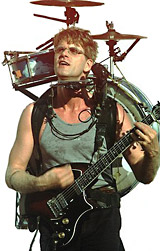 |
 |
 |
 Dazed & Confused | Whyzat? Dazed & Confused | Whyzat? 
Need the answer to a tough question?
Challenge us at Whyzat@BanderasNews.com

 Q: What is a Busker? Q: What is a Busker?

A: A Busker is a street perfomer. They owe their origins to the jesters and traveling minstrels who entertained Egyptian Pharohs and Middle Age Lords in years gone by.

To define what a Busker actually does, or is, takes some explaining. Literally defined as a person who entertains in public places for money, a Busker has no set skills they must have. They can juggle, eat fire, play music, or ride a unicycle, among many other things. As appreciation for a Busker's performance, spectators are supposed to put coins in the performer-provided hat.

You can find Buskers performing all around the world, but not all areas welcome these street performers. Laws tend to lump Buskers together as either panhandlers or vendors. Panhandlers cannot be taxed, and are illegal, so Buskers face prosecution if caught. Vendors sell goods, which is what a Busker's performance is termed, and need a permit for tax purposes. This method has its drawbacks as Buskers seldom make large profits in the first place. Often times they must be invited to perform at a location to avoid legal hassles.

Q: Where did tattoos originate?

A: The word, tattoo originates from the Tahitian word tattau, which means "to mark" and was first mentioned in explorer James Cook's records from his 1769 expedition to the South Pacific. However, some scientists believe that the earliest known evidence of tattooing dates back to markings found on the skin of the Iceman, a mummified human body that dates as far back as 3300 B.C.

More widely recognized are tattoos found on Egyptian and Nubian mummies dating from about 2000 B.C. Classical authors mention the use of tattoos in connection with Greeks, ancient Germans, Gauls, Thracians and ancient Britons.

Tattooing was rediscovered by Europeans when they came into contact with Polynesians and American Indians through their explorations. Because tattoos were considered so exotic in European and U.S. societies, tattooed Indians and Polynesians amazed crowds at circuses and fairs during the 18th and 19th centuries.

The practice of tattooing has different meanings to various cultures. Decoration was the most common motive for tattooing and that still holds true today.

In some cultures, tattoos served as identification of the wearer's rank or status within a group. For instance, the early Romans tattooed slaves and criminals. Tahitian tattoos served as rites of passage, telling the history of the wearer's life.

Q: How come we only hear about Third World countries and not First and Second World nations?

A: Third World nations are in third place because their economic development lags behind that of countries such as the U.S., Britain, and Germany, which are part of the First World (although they are rarely labeled that way). But then who are the mysterious members of World Number Two? The answer is in the history books. The three groupings date from the Cold War and originally depended on politics even more than economics. In The First World were the Western nations, those countries still economically number one today.

The Second World consisted of the Communist countries. In the Third World were those "neutral" nations committed to neither of the two main power "blocs." Many of them are still third economically. Although we don't use "Second World" any more, Russia and China would probably be in it today based on their economies.

Q: What is quicksand?

A: Quicksand consists of a buoyant blend of round granules of light sand, blended with water, or of light soil and gritty mud, or of mud peppered with pebbles. Water injects itself into the grains of any one of these mixtures, which separates and lifts them, causing them to tumble over one another, and rendering them helpless to support weighty objects.

Quicksand typically surfaces near the deltas of mighty rivers, or near shores, where a layer of stiff clay below collects and retains the water. Quicksand does not suck unsuspecting victims to their untimely deaths, a theory espoused by most until recently. This nightmarish theory did, however, provide good fodder for a host of low-budget horror films!

The discovery of quicksand's buoyant properties, akin to those of the salty Dead Sea, quashed this prevalent theory. Since quicksand is saturated with liquid, and far outweighs water, it allows anything or anyone who steps into it, to float higher than possible in water alone. The key to swimming in this non-chlorinated swimming hole, is slow motion. By moving slowly, when initially landing in quicksand, one provides the quicksand with the lead-time necessary to flow around one's body, thereby making swimming or floating possible.

Click here for more Whyzat?

Need the answer to a tough question? Challenge us at Whyzat@BanderasNews.com | 
 | |
 |
 |
 |
|



